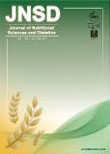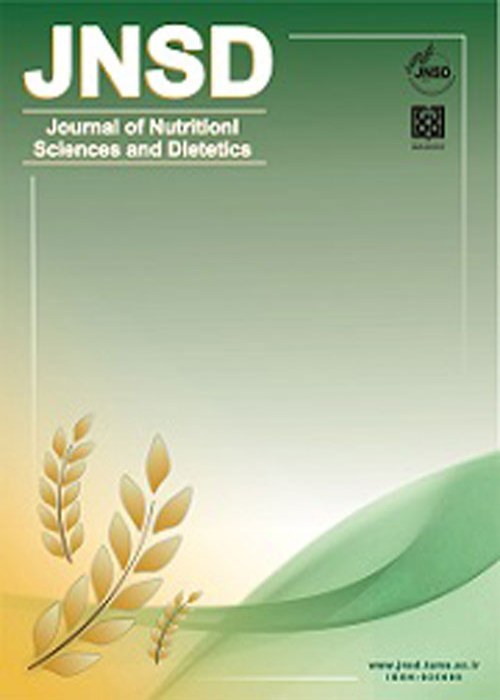فهرست مطالب

Journal of Nutritional Sciences and Dietetics
Volume:1 Issue: 1, Winter 2015
- تاریخ انتشار: 1393/10/06
- تعداد عناوین: 8
-
Pages 2-8BackgroundAlthough some studies have shown positive effects of omega-3 fattyacid supplementation on nutritional status of cancer patients undergoing differenttreatments, there is no consistency in results. The aim of this study was to examinethe effects of omega-3 fatty acid on the nutritional status of gastric cancer patientsduring the course of chemotherapy.MethodsIn a double-blind clinical trial, 30 adult patients with gastric cancerreceiving chemotherapy were randomized into a supplement and a placebo groupsand given daily, for 6 weeks, a 3-g omega-3 fatty acid supplement (containing 1.8geicosapentaeonic plus 1.2g docosahexaenoic acid) and oral paraffin, respectively.Anthropometric data was collected and nutritional status assessed at the beginning,at week 4 and at the end of week 6. The data were analyzed using repeatedmeasures ANOVA and independent sample t-test.ResultsThe findings indicated that omega-3 fatty acid supplementation increasedbody weight, mean daily intake of energy and macronutrients, serum levels oftransferrin and albumin at the end of the 6-week period significantly (p<0.05). Allthese variables decreased in the placebo group (p<0.05). The increases in bodyweight, energy and carbohydrate intakes, and serum levels of albumin in thesupplement group were time-dependent (p<0.05).ConclusionThe results of present study showed that omega-3 fatty acidsupplementation can improve nutritional status in patients with gastric cancerduring the course of chemotherapy. We recommend using omega-3 fatty acidsupplement in patients with gastric cancer during chemotherapy.Keywords: Omega 3 fatty acid_Weight_Nutrition_Gastric cancer_Chemotherapy
-
Pages 9-20BackgroundAlthough it is widely accepted that the pre-school age is a criticalperiod in the development of obesity, there are few published data on factorscontributing to variation of total energy expenditure in this age group.To investigate the contribution of body composition, gender and activity on totalenergy expenditure (TEE) in pre-school children.MethodsThe total energy expenditure of 89 children (2-6 years old) was measuredusing the doubly labelled water (DLW) technique. Total and regional bodycomposition were also measured using deuterium dilution and dual energy X-rayabsorptiometry (DXA) respectively. Physical activity and sleep patterns wereevaluated using an accelerometer. Principal components analysis (PCA) wereperformed on regional fat mass (FM), regional fat free mass (FFM) and behaviouralvariables (activity, inactivity and sleep patterns), to generate orthogonal predictorsfor regression analyses.ResultsNo significant difference was found between boys and girls for, log weight,height, BMI sds, total FFM and log FM measured by DXA and total FFM and logobtained with deuterium dilution. No significant gender difference was found forregional traits of FFM and FM except for trunk’ FFM (p=0.02) and legs’ FFM(p=0.04), which were higher in boys. FFM and FM measured by DXA explained70.9% of the variation in TEE, and TEE was significantly lower amongst girls afteradjustments for body composition were made (p<0.01). The first component of FFM(PC1-FFM), FM (PC1-FM) and behavioural variables (PC1-BV) were positively(p<0.01) related to TEE and there was a significant negative relationship with PC2-FM (p<0.05) and PC4-BV (p<0.01).ConclusionMost variation in TEE in this group was explained by difference inFFM and FM. Behavioural factors, particularly time spent in high activities couldmake an additional contribution of 20.9% in variation of free-living TEE. Moreresearch is needed to confirm these findings in other population.Keywords: Energy metabolism, Childhood obesity, Physical activity, Activity monitor, Dual energy X-ray absorptiometry
-
Pages 21-27BackgroundThere have been a number of reports indicating that garlic caninhibit helicobacter pylori (H. pylori) in vitro; however, there is few clinical trialsevaluating its effect in human infection. The aim of this study was to assess theeffect of garlic consumption on urea breath test (UBT) results in patients with H.pylori infection.MethodsWe performed a randomized case-controlled design on 36 outpatientsdiagnosed with H. pylori infection. In order to confirm the presence of H. pyloriinfection, the UBT was performed and in order to examine the presence ofinflammation and/or ulcer in stomach, esophagus and duodenum, upper endoscopywas performed at the beginning and the end of the study. The patients in the casegroup took four grams of garlic powder daily (two tablets each containing twograms of garlic powder) whereas the patients in the control group took twoplacebo tablets (each containing two grams of white flour) for 8 weeks.ResultsThe average age was 40.87± 16.45 in case groups and 35.40±11.26 in thecontrol group. In the control group, 47% were men and 53% women, 80% marriedand the rest were single. At the beginning of the study, all the patients had positiveUBT. At the end of this study, the results of UBT showed that the H. pyloriinfection was negative in 87% of cases and 73% of control group showingeradication of H. pylori infection; however the eradication in case group was notsignificantly more than control group.ConclusionThis study did not support a role for garlic in the treatment of H.pylori infection.Keywords: Helicobacter. pylori, Garlic, Urea Breath Test
-
Pages 28-36Diet as a part of lifestyle plays a pivotal role in the development of metabolicsyndrome and its consequences. Fatty acid composition as a part of dietary intakeaffects blood fatty acid concentrations, insulin sensitivity and different metabolicpathways associated with the occurrence and consequences of the metabolicsyndrome. The aim of this review is to evaluate the effects of dietary fatty acidcomposition on metabolic syndrome (MetS) and its components. A search wasconducted through PubMed, Google scholar and Science Direct using keywordsincluding metabolic syndrome, MetS, diet, fatty acid composition, saturated fattyacids, monounsaturated fatty acids, polyunsaturated fatty acids, omega3, omega6and fish oil, insulin resistance, hyperlipidemia, obesity and blood glucose. Weincluded English articles published from 1995 to 2014. Based on the results of thestudies reviewed, intake of saturated fatty acids by increasing LDL-C, totalcholesterol and oxidized LDL and arterial stiffness was associated with increasedinsulin resistance and metabolic syndrome. In contrast, supplements containingomega-3 and monounsaturated fatty acids such as fish and rapeseed oil can reducethe risk of metabolic syndrome and its consequences risk factors by loweringtriglycerides, cholesterol, inflammation and oxidative stress. Low intake ofsaturated fatty acids and monounsaturated fatty acids with increased intake ofomega-3 polyunsaturated fatty acids may be useful in reducing the risk ofmetabolic syndrome and its consequences.Keywords: Dietary fat, Dyslipidemia, Fatty acid, Insulin resistance, Metabolic syndrome
-
Pages 37-43BackgroundObesity is a consequence of the excessive accumulation of fat inadipose tissue which can result in significant morbidity and mortality. Obesity is amajor health problem in Iran. The aim of this study was to investigatethe effects of EPA consumption on BMI and fasting blood sugar by FABP2genotypes and PPARα (Leu162Val, and G/C intron polymorphism) genotypes.MethodsA total of 170 hypertriglyceridemic subjects were selected andgenotyped for Ala54Thr, using a polymerase chain reaction–restriction fragmentlength polymorphism (PCR-RFLP) method. After determination of their FABP2genotypes, the first 23 eligible subjects who were determined as Ala54 carriers andthe first 23 eligible Thr54 carriers were enrolled in the study. Participants took 2g/d of pure EPA (four gel caps, each containing 500 mg of ethylester EPA 90%).Height and weight were measured by a Seca scale with light clothing and no shoeson. BMI was then calculated. Waist and hip circumferences were measured with aflexible tape.ResultsEPA supplementation decreased fasting blood sugar in Ala54 and Thr54(p<0.001). No significant association was observed between BMI or fasting bloodsugar and different FABP2 genotypes after EPA consumption. EPAsupplementation increased BMI and decreased fasting blood sugar in Lue162 andVal162 (p<0.01), and interon 7 polymorphism (p<0.01). No interaction wasobserved between PPARα genotypes and degree of changes in BMI or fastingblood sugar after EPA supplementation.ConclusionAlthough EPA consumption showed the effect of EPA response on FBSin Ala54 or Thr54 and Leu162 or Val162 in FABP2 and PPARα genotypes but nointeraction was observed between these genotypes and EPA supplementation.Keywords: Body Mass Index, Eicosapentaenoic acid, Fatty acid binding protein 2, Fasting Blood Sugar, PPARα genotypes
-
Pages 44-52BackgroundLiver cancer is one of the deadly cancers with high prevalence inthe East Asia. Likewise most of diseases, herbs and herbal medicine could be aneasy and cost effective tool in prevention and possible cancer treatment. Thepresent study investigated the ability of Orthosiphon stamineus Benth decoction toprotect liver against hepatocellular carcinoma in carcinogenesis-induced animalmodel.MethodsForty male Sprague Dawley rats (age: 8±1 weeks, weight: 248.1±7.21g)were obtained and 10 rats were kept as normal group. Hepatocellular carcinomawas induced for the rest 30 of rats by means of intraperitoneal injection of200mg/kg diethyl nitrosamine (DEN) dissolved in corn oil. Induced cancer ratswere under hepatocarcinogenesis promoter diet made from a mixture of standardrat diet (AIN-76) with 2-acetylaminofluorene (0.02% AAF) for two weeks. Twoweeks after this diet, left over rats were divided to two groups as control andtreatment. Treatment group, were forced feed daily with 0.7 ml O. stamineusdecoction.ResultsAfter 28 weeks treatment with O. stamineus decoction, serumbiochemical markers including alpha fetoprotein (AFP), alkaline phosphatase(ALP), aspartate aminotransferase (AST), alanine aminotransferase (ALT),corticosteroid binding globulin (CBG), gamma glutamyl transferase (GGT),homocysteine (HCY), tumor necrosis factor alpha (TNF-α), and alpha 2macroglobulin (α2MG) have been regulated favorably. Total antioxidant status(TAS) also has been increased drastically. Liver lesion score in treated groupswere reduced and glucocorticoid activity has been amplified significantly.ConclusionOur results indicate that O. stamineus decoction might prevent orsubdue liver cancer development.Keywords: Cell proliferation, Glucocorticoid, Cell receptors, Phytochemicals, Caspase
-
New emerging correlates of weight satisfaction in women: husband-related factors and caffeine intakePages 53-61BackgroundWeight satisfaction is an important determinant of weight-relatedbehaviors and may result in overweight, obesity or eating disorders. To assessweight satisfaction and its related factors, including dietary intake and spouserelatedfactors, in adult women.MethodsThis is a descriptive-analytic cross-sectional study carried out in Northof Iran. Through random sampling, 450 women aged 22-55 years under coverageof health centers were recruited from May 2012 to February 2013. Data werecollected by face to face interviewing the individuals. Participants’ height, andweight and waist circumferences were recorded. Body mass index (BMI) wascalculated. We used the 24-hour recall questionnaire to estimate food intake in twodays of the week. Weight satisfaction was evaluated through questioning.Multivariate logistic regression was used to determine the major factors related toweight satisfaction.ResultsWeight satisfaction was 62.4% among women. About 70% of womenwere overweight or obese (BMI≥ 25 kg/m2). The odds of weight dissatisfactionwere higher in younger, healthy individuals and those who take more caffeine on adaily basis. Moreover, the odds of weight dissatisfaction were lower inunderweight/normal weight (BMI< 25 kg/m2) women and the overweight women.In addition, the rate of dissatisfaction was significantly higher in women whobelieved their husbands are dissatisfied about their weight and women whosehusbands were in fact dissatisfied about their weight.ConclusionWeight satisfaction was prevalent in participants and related to age,disease status, caffeine intake, BMI and husband-related factors.Keywords: Body mass index, Husband, related factor, Weight loss behavior, Weight satisfaction


